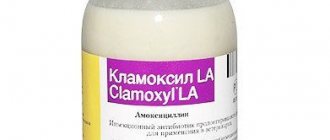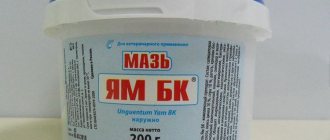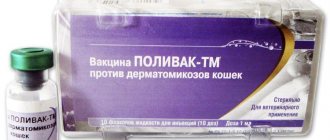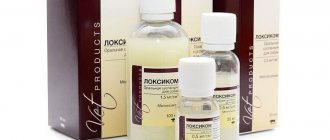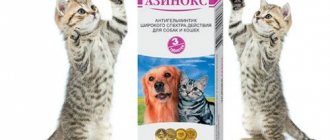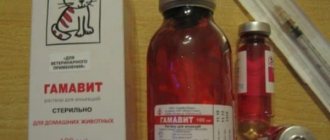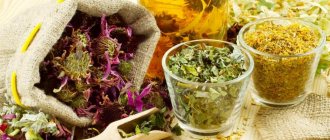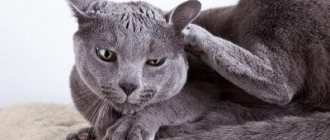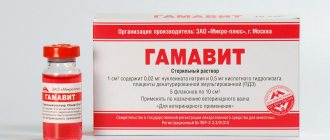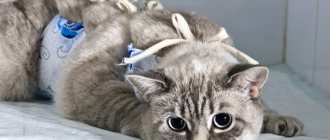As cats age, just like people, they can experience problems with their joints and bones.
To treat such diseases, the medicine Artroglycan for cats was invented. This is a chondroprotector created specifically for animals. The microelements and vitamins it contains contribute to a beneficial effect on cartilage tissue and relieve inflammatory processes.
They also help produce fluid in the joints, which lubricates them and allows the animal to move without pain.
Composition and release form of the drug: active substances
The drug is available in tablet form.
The medicine is produced in a pack-pack, decorated in yellow tones; inside there are about 30 tablets of 0.7 g each (3 blisters of 10 pills each). There is another format - a jar that can hold 300 tablets at once. Artroglycan is produced in St. Petersburg (Russia).
Main active substances (in mg):
- 200 - chondroitin sulfate;
- 100 - glucosamide hydrochloride and calcium gluconate;
- 50 — selenomethionine;
- 20 - vitamin E.
Minerals, vitamins and trace elements help Artroglycan act locally on cartilage tissue, while simultaneously relieving inflammatory processes. Additionally, there is an increase in the production of joint fluid, which lubricates the joints and allows the animal to move without pain. The color of the tablets is pale gray.
This is interesting: Why does a cat breathe with its mouth open?
Artroglycan for dogs composition
The drug is produced in tablets, packaged in blisters of 10 pieces.
The medication is sold in cardboard packs of 30 and 300 tablets. It is produced in Russia by several pharmaceutical companies, one of which is Biocenter ChN in St. Petersburg. The drug consists of:
- Glucosamine hydrochloride - 100 mg. Synthesizes glycosaminoglycan sugars necessary for the formation of cartilage and forms collagen;
- Vitamin E - 20 mg. Antioxidant. Strengthens the immune system. Promotes the body's absorption of the active substances of the drug;
- Chondroitin sulfate - 200 mg. Retains liquid. Provides joint cushioning that prevents abrasion of the joints;
- Selenomethionine - 50 mg. Prevents H2O2 hydroperoxide from entering the cell, which is harmful to its development;
- Calcium gluconate - 10 mg. Strengthens the skeleton, muscles and nervous system.
The active ingredients of the drug are in a strict ratio necessary to streamline metabolic processes and rehabilitate the cells of the cartilage matrix. The chondroprotector artroglycan also has anti-inflammatory, analgesic and anti-edematous effects.
Pharmachologic effect:
- tissue regeneration improves;
- joint mobility improves;
- cartilaginous surfaces and joint capsules are rehabilitated;
- degenerative processes in cartilage cells are frozen;
- joint fluid is well produced;
- capillaries are strengthened;
- muscle mass increases;
- calcium enters and accumulates in the bones;
- natural antioxidants, selenomethionine and vitamin E promote good liver and cardiovascular system function. Have a beneficial effect on lipid oxidative processes.
After completing the course of treatment, the pet can move fully without feeling stiffness or inflammation in the joints. These drugs can be purchased
Artroglycan for cats
Artroglycan is a veterinary drug that is used when it is necessary to strengthen and restore connective tissues and cartilaginous tissues. The drug is prescribed not only for the prevention of problems with the musculoskeletal system in animals, but also for the treatment of existing diseases.
Instructions for the medicine
Artroglycan is available in the form of light gray tablets.
Artroglycan - composition:
Chondroitin sulfate (0.2 g) - helps reduce calcium excretion, slows down the process of destruction of bone tissue;- Glucosamine hydrochloride (0.1 g) - necessary for the production of joint fluid;
- Calcium gluconate (0.1 g) - stabilizes metabolic processes in tissues;
- Selenomethionine (50 mcg) is a trace element that improves immunity and has a positive effect on the heart;
- Vitamin E (0.02 g) - antioxidant, immunostimulant, promotes tissue regeneration, etc.
The substances contained in the drug have a targeted effect on cartilage tissue , relieve inflammation, have an analgesic effect, improve the reproduction of joint fluid, and have a positive effect on the functioning of the animal’s heart and liver.
Analogues of the drug
If an allergic reaction to Artroglycan is detected in a cat, it can be replaced with similar drugs. The following medications are similar in composition to this drug:
- Felvit Hondro. This veterinary drug is produced in tablet form by a Czech company and is suitable for both adult cats and kittens. It maintains good joint mobility and prevents inflammatory processes in the ligaments.
- Superflex. The drug is available in the form of a liquid supplement, which is especially convenient to give to kittens by adding it to their food. It is an effective chondroprotector for pets, helping them recover faster after surgery and injury.
- Stride plus. A complex anti-inflammatory agent that has an analgesic and antipyretic effect. Available in the form of a liquid food supplement.
- Polegen. The most inexpensive drug aimed at strengthening cartilage. It contains additional components such as zinc and beta-carotene. This vitamin and mineral food supplement also improves the condition of your pet's skin and coat.
Chondroprotectors are also produced in the form of treats. Some of the most famous and effective dietary supplements are Glyco Flex III and Joint Max. The latter is a powder that needs to be mixed into your pet's liquid food.
Contraindications, dosage, analogues
Contraindications include individual intolerance to the components of the drug.
The drug can be purchased at any veterinary pharmacy . Its price will depend on the packaging: the drug is available in boxes of 30 pieces. (3 blisters of 10 tablets each) and in plastic jars of 300 pieces - of course, the price will differ.
Analogs: Tsamaks, Biolysin Artro. These drugs differ in composition, but their principle of action is identical. But remember: any medicine should only be prescribed by a veterinarian!
The child asked to get a cat. The choice fell on the Maine Coon - the cats are beautiful, large (there is something to squeeze). But when the cat began to grow, we began to notice that he was limping or something. We ran to the vet. The doctor examined him and said that we are feeding him too hard (well, how can we not feed him if he is the one he loves and asks for it?), the cat is growing, but his joints cannot keep up with him. We were prescribed Artroglycan. I read reviews on cat lovers forums - they seem to praise it. They started giving. After a while, I noticed that the cat’s lameness began to go away . So he helped our Balthazar.
I have a folded bun in the house. I began to notice that the cat somehow reluctantly jumped onto her lap, on the bed - but this used to be her favorite place to stay! And then it all started: she couldn’t touch her paws, hissed, she started walking with difficulty (she takes a couple of steps and then lies down), she even ate while lying down! We rushed to the hospital, because we had no strength to look at it.
They took an x-ray. It turned out that my favorite bun has osteochondrosis. Arthroglycan was prescribed. It has an analgesic effect - the cat immediately felt better. We took the course and the cat began to walk normally and generally behave like a cat: jumping, hunting for legs. But the doctor warned not to throw the drug too far: in damp weather a relapse is possible. So now we always have this remedy.
Anna
Artroglycan reviews
We have a beautiful fold-eared cat at home who has always been playful and active. It seemed like she had been replaced a couple of months ago. My pet has become lethargic and unsociable. She did not allow herself to be petted and lay around a lot. Suspecting something was wrong, we went to the veterinarian, who diagnosed “osteochondrosis” and prescribed treatment with Artroglycan. Thanks to the analgesics included in the composition, the cat began to behave as before again. A month later we forgot about the problem completely! The doctor recommended having the medicine in my arsenal, because due to age, joint pain may return. Natalia
When my son asked to get a kitten, we didn’t think twice about it. I've always loved pets. Our cat initially had a good appetite, in addition to food, my son often fed him, even though I forbade it. Three months later, I noticed that Timoshka (the cat) began to limp. I thought he fell and injured his paw. During the examination, the veterinarian advised to limit the pet’s food intake, because the weight gained had increased the load on the joints. Artroglycan was recommended for treatment. The drug helped literally immediately and the lameness went away. I will definitely recommend the medicine to other cat owners with similar problems! Julia
How I CURED A CAT after a stroke
Visit the profile section of our Medical Examination forum or leave your feedback in the comments below. More opinions means more useful information, it will be useful to someone. If there are good and interesting videos on the topic of the article, write and I will insert them into this publication.
Contraindications and side effects
The drug does not cause side effects when used correctly. The only exceptions are those cases when the dosage has been exceeded. The pet exhibited the following symptoms:
- severe itching;
- rashes;
- redness of the skin;
- stool disorder;
- indigestion.
Contraindications to the use of this drug are individual intolerance to one or more components of the drug and the presence of changes in cartilage and bone tissue caused by fungal, bacterial or viral infection.
Pharmacological properties and indications for use
The properties of "Artroglycan" are based on the complex action of the active substances included in its composition:
- chondroitin - prevention of degenerative changes in bone tissue, regulates calcium levels;
- glucosamine - responsible for restoration processes in cartilage;
- selenomethionine - strengthens the immune system;
- Vitamin E is an antioxidant that protects cells from free radicals;
- Calcium gluconate is responsible for interstitial metabolism.
Did you know? Another name for vitamin E
, tocopherol, literally translates as “progeny-bearing.”
This name was proposed due to the properties of the substance identified during research to restore fertility in rats. The combined use of the above components and their overall effect has a synergistic effect, which is expressed in the following manifestations:
- has a beneficial effect on metabolism in cartilage tissue and promotes its regeneration;
- returns flexibility to joints;
- has anti-inflammatory and analgesic effects;
- helps replenish the loss of calcium, tocopherol and selenium;
- protects the walls of blood vessels;
- has a positive effect on the heart and liver;
- takes part in the production of bone tissue.
Thanks to its unique qualities, “Artroglycan” is successfully used in the treatment of the following diseases in animals:
- degeneration of joints and spine;
- chondrosis, arthrosis, arthritis and joint porosity;
- spondylosis;
- dysplasia.
It is also appropriate to use the product in the following situations:
- During pregnancy , especially if the animal is 5 years old or more. During pregnancy, the mother's body loses a large amount of calcium. A lack of this element can cause decalcification of bone tissue. At this age, the dog especially needs vitamins and minerals, the drug will help replenish them.
- After birth, the need for calcium increases due to feeding puppies or kittens, so taking Artroglycan would be quite appropriate. It will help the animal recover after birth and improve the quality of milk.
- The drug has also proven itself in gerontological veterinary medicine. Due to its beneficial effect on the heart, liver and strengthening effect on blood vessels, “Artroglycan” is successfully used for older animals.
This is interesting: What to do if a cat yells at night?
Arthroglycan analogues for dogs
Tsamaks and Biolysin Artro, in their chemical composition, are closest to Arthroglycan.
The food vitamin supplement Tsamax contains collagen hydrolysate, ascorbic acid, spirulina (algae), but does not have calcium. The active ingredient is natural zeolite. Available in powder form. The medicine is completely tasteless and odorless, so it can be easily mixed into your dog’s food.
Kutenku powder is usually poured into milk. It has amazing absorbent and antioxidant properties. It is also a combination of powerful multivitamins that strengthen the animal's immune system. The drug is produced by domestic manufacturers. Has many variant lines. There are no side effects.
The dose is calculated taking into account the body weight of the animal, at the rate of 0.5 g per 1 kg of weight. The daily dose is 1 tablet once a day. The duration of treatment is 3–4 weeks. At the discretion of the veterinarian, the course of treatment can be repeated after two weeks.
Should be stored in a cool, dark place out of reach of children for no more than 2 years.
The drug Biolysin Artro contains calcium, glucosamine, chondroitin, but it does not contain selenium and vitamin E. It is produced by Russian manufacturers. It has two options - for Great Danes and Retrievers/Shepherds. This is a powerful remedy for the regeneration of cartilage tissue.
It has an anti-inflammatory, anti-allergenic and chondroprotective effect in the treatment of the musculoskeletal system. Helps quickly recover from injuries. It is used for both therapeutic and prophylactic purposes (during the period of spring-autumn exacerbation and under increased stress). Available in tablets.
The dose is calculated taking into account the body weight of the animal, at the rate of 1 tablet per 10 kg. Daily intake: 1 tablet 1 – 2 times a day. The duration of treatment is 1.5 months.
Should be stored in a cool, dark place out of reach of children for no more than 2 years.
>Price for artroglycan for dogs
Artroglycan for dogs price 300 tablets
2100‒2250 rubles
Artroglycan for dogs price 30 tablets
250‒280 rubles.
Directions for use, course of treatment and dosage
"Artroglycan" is a broad-spectrum drug. Suitable for many pets. Depending on the type of animal you have, its weight and age, the course of treatment and dosage of the drug are calculated.
Important! The basic dosage rule for “Artroglycan” for any animal is 1 tablet for every 10 kg of weight.
But in any case, before taking the product, you should consult a veterinarian. There is no need to make a diagnosis or prescribe treatment yourself. There are specialists for this. The effect of taking the drug does not occur immediately; positive changes should be expected no earlier than 15-20 days after the start of treatment.
Dogs
The usual dose for dogs is 1 tablet for every 10 kg of weight. The instructions for use of the drug "Artroglycan" indicate that a single dose of the drug should not exceed 4 tablets. Therefore, large animals are given the drug 2 times a day, morning and evening. The course of treatment is 1-3 months. You can use the tablets by first grinding them into powder and adding them to food. The drug is poorly soluble in water.
For dogs at risk, it is advisable to take the drug prophylactically twice a year for 3-4 weeks. In this case, the dosage is 1/2 the therapeutic one. For such dogs, as well as inactive or overweight animals, the drug is recommended as a prophylaxis from the age of three. Representatives of other breeds can be given it from the age of six.
Important! Veterinarians recommend starting to use the vitamin complex not only during pregnancy, but also 3 weeks before mating.
Owners of breeds with erect and semi-erect ears should pay special attention to the drug. To strengthen the ear cartilage in such dogs, it is recommended to use chondroprotectors as prophylactic agents. "Artroglycan" will cope with this function perfectly. The drug will help puppies during teeth growth. During this period, the body needs a large amount of calcium, the source of which is “Artroglycan”. The anti-inflammatory effect of the drug will help prevent gum inflammation.
Cats
Depending on the weight of the cat, the dosage of “Artroglycan” is as follows:
- 3–4 kg - 1/4 tablet;
- 5–6 kg - 0.5 tablet;
- 7-8 kg - 3/4 tablet;
- 10-12 kg - 1 tablet;
- 12-15 kg - 1.5 tablets.
For cats that have an individual intolerance to the product, analogues can be selected. Some of them are listed below:
- "Felvit Chondro";
- Stride plus;
- Polegen;
- Joint Max.
Rats and ferrets
For representatives of rodents and mustelids, the indications for use are the same as for other mammals. The details relate only to the dosage of the product. Due to the small mass of rats, ferrets and related pets, the usual dose is 0.5 tablets 2 times a day.
In what cases is it prescribed
Artroglycan belongs to chondroprotectors, substances that are a kind of “builders”. They are actively involved in the restoration of cartilage tissue damaged naturally or as a result of injury. The spectrum of action of the substances is wide. They not only “build” cartilage, but also nourish it. Artroglycan is prescribed to dogs, cats, decorative rats, and ferrets. The product effectively restores and strengthens the joints and bones of animals. Artroglycan helps cope with a number of diseases .
- Intervertebral osteochondrosis.
- Osteoarthritis.
- Spondylosis.
- Arthrosis.
- Joint dysplasia.
© shutterstock
The use of this innovative medicine is especially recommended in the spring and autumn months. No side effects were found after numerous studies and careful observations. But the positive effect of the drug on the entire body as a whole has been proven more than once. However, before using Artroglycan, it is necessary to obtain competent consultation from a specialist. Every cat's body is different. It is possible that allergic reactions to the drug may occur.
How to give the drug to a cat
If a cat has diseases of the spine or joints, many experienced veterinarians prescribe Artroglycan. The Russian medicine inspires confidence among specialists and a lot of eloquent reviews from grateful breeders. The dosage of Artroglycan for cats is prescribed individually. In addition, if the pet is a heavy breed, then the drug should be combined with specially developed food. As a preventative measure, it should be used exclusively in the autumn-spring period. This will help support the animal’s weakened immunity.
When using Artroglycan, you must strictly follow the instructions provided. It contains detailed instructions regarding safe daily doses, calculated for both cats and dogs, ferrets, and rats. The drug must be purchased with the expectation of long-term use. Artroglycan is given to the cat for at least 3-4 weeks twice a day, thoroughly mixed with food. A specific dosage must be observed, calculated depending on the weight of the pet. For 10 kg – 1 tablet. If the cat has complex joint diseases, the course of treatment is increased to 2-3 months.
For what diseases is it prescribed?
Artroglycan is used to treat the following diseases:
- primary arthrosis (the initial stage of a chronic disease in which gradual damage to the cartilage tissue of the joint occurs);
- intervertebral osteochondrosis (a disease of the spine caused by changes in its discs);
- osteoarthritis and osteoarthritis (damage to cartilage);
- spondylosis (a chronic disease in which bone outgrowths form on the vertebral bodies);
- osteoporosis (disorder of metabolic processes in the body, which results in a decrease in bone density and strength);
- joint dysplasia (pathological processes that lead to their abnormal development).
Also, sometimes veterinarians prescribe this drug to prevent calcium deficiency in kittens, pregnant cats and when changing teeth, for fractures and dislocations.
Most often, problems with the spine and joints occur in large overweight cats.
Overweight cats are more likely to develop joint diseases.
pharmachologic effect
Artroglycan has a wide spectrum of action. It helps to cope with the following diseases: arthrosis of the first degree; pain in the spine and joints; osteochondrosis; spondylosis; osteoarthritis; osteoporosis; articular dysplasia. Artroglycan has the following actions: Strengthens the walls of blood vessels. It is a chondroprotector. Effectively relieves pain. Fights inflammatory processes. Launches regenerative processes. Stops the destruction of cartilage. Restores the joint capsule and cartilaginous surface. Activates the process of restoration of cartilage and bone tissue. Regulates calcium reserves. Promotes muscle growth. Has a beneficial effect on the functioning of the heart. Replenishes the deficiency of selenium, calcium and vitamin E. Due to its extensive effects on the body of cats, the drug is actively prescribed by veterinarians.
Indications for use of the drug Artroglycan
- Degenerative diseases of the joints and spine;
- Primary arthrosis;
- Intervertebral osteochondrosis;
- Osteoarthritis;
- Osteoarthritis;
- Spondylosis;
- Osteoporosis;
- Joint dysplasia.
Degenerative diseases of the joints and spine
Although such diseases more often plague dogs than cats , it still cannot be said that they do not occur at all in cats. Adult cats often have joint problems. In addition to age, problems with joints can also begin against the background of infectious diseases, injuries, and often problems with joints are the “calling card” of a certain breed:
- Abyssinian and Devon Rex cats are prone to sprains;
- Maine Coons, Persians and Siamese are prone to such pathologies as hip dysplasia;
- Scottish Folds are prone to severe arthritis, etc.
Symptoms of the development of degenerative changes in a cat’s body:
Animals begin to limp;- Reluctance to jump on sofas, beds, or climb stairs;
- After the cat rests, it is difficult to get up, the pet’s gait becomes difficult, it is clear that it hurts to walk;
- The cat often licks the joints when he “washes” with his tongue;
- The animal becomes irritable: when trying to pick it up or even just pet it, the pet begins to rumble, hiss, or even try to bite.
Primary arthrosis, intervertebral osteochondrosis
Primary arthrosis is a chronic disease that is non-inflammatory in nature . Most often it affects older animals and representatives of large breeds. Associated with the process of natural aging of the animal’s body:
- Metabolic processes slow down (blood exchange in bone tissue becomes longer);
- The cartilaginous structure of the joints wears out and wears out;
- The vitamin and mineral balance is disturbed.
With intervertebral osteochondrosis, the mobility of the spine decreases. Excessive load on the spine (for example, overweight in a pet) or injury can cause the intervertebral disc to shift and begin to compress the nerve roots that extend from the spinal cord, and sometimes the spinal cord itself. Neglect of treatment can lead to complete paralysis of the animal's hind limbs. The development of osteochondrosis largely depends on the diet of your pet: an excess of calcium in the diet can lead to its excess beginning to be deposited on the joints.
Osteoarthritis and osteoarthritis
Osteoarthritis is a form of chronic joint inflammation when joint mobility is lost (usually the shoulder and elbow joints in older animals). It can also be caused by injuries: dislocations, fractures in which the joints were affected. Osteoarthritis is degenerative changes in joint tissue.
Reasons for development:
Congenital disorders (for example, this disease can often be observed in Scottish cats);- Injuries;
- Consequences of surgical interventions (for example, when removing the claws of cats - this operation is prohibited in many countries of the world. It leads to disruption of absolutely all functions of the musculoskeletal system, since the claws are removed along with the upper phalanx of the finger, cats suffer from chronic pain syndrome. Or after tendoectotomy - cutting the tendon of the finger, as a result of which the cat cannot move its claws. In animals that have undergone these operations, the risk of developing arthrosis is enormous);
- Age-related changes;
- Load on the joints (excess weight of the pet);
- Metabolic disorders.
Spondylosis and osteoporosis, joint dysplasia
Spondylosis is a pathology of the spine that affects older cats. With spondylosis, processes (osteophytes - bone spurs) form between the vertebrae, which begin to put pressure on the bone marrow. Most often, such lesions occur in the lumbar and sacrum areas.
Osteoporosis is a decrease in bone mass in cats . Causes:
- Lack of calcium (more common in those animals whose main food is meat);
- Parathyroid tumor (benign or malignant);
- Age;
- Chronic kidney and gastrointestinal diseases.
Joint dysplasia is a complex pathology in which the articular head and socket do not coincide. Reasons include heredity and rapid growth of the animal (large breed cats).
Symptoms:
- Weakness of limbs damaged by dysplasia;
- Limited movement;
- Wobbling gait;
- Thinness of limbs;
- Painful sensations.
Who is Artroglycan prescribed for?
This drug is not classified as a medicine, but as a vitamin supplement. Therefore, veterinarians recommend using Artroglycan for preventive purposes for dogs. Reviews from owners who began giving their pets the drug from the age of 6-7 note that the animal retained joint mobility and freedom of movement longer. It is recommended to conduct such preventive courses twice a year in the spring and autumn, when the lack of vitamins is especially felt.
Most often, Artroglycan is prescribed to dogs after the age of six, but there are breeds that are more susceptible to joint diseases than others. These are Pekingese, Yorkshire terriers, Rottweilers, collies, Labradors, dachshunds and some others. These dogs are recommended to be given the drug for preventive purposes from the age of three. It is also useful for puppies, because it contains substances necessary for the pet for the normal formation of bone tissue. In addition, “Artroglycan” is prescribed for the treatment of the musculoskeletal system, diseases of the joints and spine.
Video: joint and bone diseases in cats
Joint and spinal diseases in cats require mandatory treatment. Preventative measures are also very important. In order to maintain joint mobility and health of the musculoskeletal system for a long time, you need to give it chondroprotectors such as Artroglycan.
Higher education, mother of two children, early childhood educator, primary school teacher.
(4 votes, average: 4.3 out of 5)
- Track. Prazicide for cats against worms
- Prev. How to understand that a cat has panleukopenia
Application area
Artroglycan for cats and dogs is used in the treatment and prevention of diseases of the musculoskeletal system such as:
- Osteoarthritis
- Osteoporosis
- Osteoarthritis
- Spondylosis
- Arthrosis
- Joint dysplasia
- Degenerative diseases of the spine and joints
- Intervertebral osteochondrosis.
It is important for owners of cats and dogs to remember that artroglycan is recommended to be used not only for the treatment and prevention of the above-mentioned diseases of the musculoskeletal system in elderly individuals. The drug will also be useful for puppies or kittens as a prevention of rickets and when changing teeth.
Dosage
Before using the drug "Artroglycan", you must study the instructions and also calculate the dosage correctly.
The drug is most often used for dogs, so the tablet size exceeds the dose required for a cat. To calculate the optimal amount of active ingredient, refer to the table:
- A single dose for animals from 3 to 4 kilograms is a quarter of a tablet;
- Cats weighing 5 kg should be given half a pill;
- Large breeds 6-7 kg should consume ¾ tablets.
Typically, tablets are given to animals twice a day, however, the individual dosage must be determined by a veterinarian.
The duration of the course should be one month. In some severe cases, therapy is carried out for 2-3 months.
Instructions for use for rodents
Artroglycan can be used in the treatment and prevention of diseases of the musculoskeletal system not only in cats and dogs, but also in domestic rodents such as ferrets, rats, and guinea pigs.
The instructions for use recommend a dosage of ½ tablet 2 times a day. The drug is mixed with food. The exact course of treatment is prescribed by a veterinarian, but it must last at least 3-4 weeks. It is also recommended to give artroglycan to rodents to prevent calcium deficiency in the autumn-winter period.
How do chondroprotectors work?
Before you start giving your cat Artroglycan, you should understand how it works. To do this, it is enough to understand the structure of cartilage. After all, Artroglycan is prescribed to cats precisely for its maintenance. Healthy pet joints have a smooth surface. It is covered with cartilage tissue that produces a special synovial fluid. Its volume depends entirely on the mobility of the joints. It is necessary to understand that it is this liquid that nourishes the cat’s cartilage, which, if deformed, can become exposed, causing irreversible consequences. Taking Artroglycan has a number of advantages.
- It has a pronounced mechanism for restoring cartilage tissue, analgesic and anti-inflammatory properties.
- It is easily tolerated by cats without causing any side effects. The only exception may be individual intolerance to certain components of the drug.
- In addition to the symptomatic effect, it also has a pathogenetic effect. Artroglycan normalizes metabolism in cartilage, restoring the structure and significantly improving metabolism.
What to pay attention to
If a breeder decides to self-medicate a cat or use a drug for preventive purposes, it is necessary to carefully read the instructions for the drug. The main thing you should pay special attention to is dosage and side effects . In addition, you need to know that the use of Artroglycan is prohibited in case of infectious lesions of ligaments and joints. In other cases, the drug is absolutely harmless to the cat and causes allergic reactions extremely rarely. The side effect disappears immediately after stopping Arthroglycan.
Real reviews
Polina, 32 years old:
“I began to notice that Jessie began to limp. The veterinary clinic did an x-ray, but no bruises, fractures or cracks were detected. The doctor said that due to age (my favorite is already 14 years old), joint disease is developing. He advised me to give Artroglycan. I liked that there are no synthetics in the composition. In the first few weeks no improvement was noticed. But after 1.5 months the dog became more willing to go for walks. Therefore, I can recommend the drug.”
Gregory, 39 years old:
“I bought Artroglycan on the advice of a pharmacist at a veterinary pharmacy. I have a mastiff that weighs almost 60 kilograms! Therefore, already at the age of 4 he began to have problems with his joints. I was very afraid that the dog would simply “fall”, since his paws might not be able to withstand such weight. I decided to carry out preventive treatment. What was alarming was that there were no instructions in the box, even though the price of the drug was almost 2000 rubles. There were only general instructions on the cardboard packaging itself. Gave 2 tablets in the morning and evening. The most important thing is that within a month the dog began to run normally and stopped licking his joints. So the drug is effective, and it’s from a Russian manufacturer.”
Marta, 27 years old:
“I adopted a yard puppy to guard the dacha, but did not notice that he had problems with his paw. As a result, already at 8 months the dog stopped walking. The veterinarian said that the joint may have been dislocated and now the cartilage tissue needs to be restored. Since most medications cannot be given to small puppies, we were prescribed Artroglycan. The tablets are expensive (considering that you need to take them for three months), but they really have an effect.”
As cats age, just like people, they can experience problems with their joints and bones. To treat such diseases, the medicine Artroglycan for cats was invented. This is a chondroprotector created specifically for animals.
The microelements and vitamins it contains contribute to a beneficial effect on cartilage tissue and relieve inflammatory processes.
They also help produce fluid in the joints, which lubricates them and allows the animal to move without pain.
